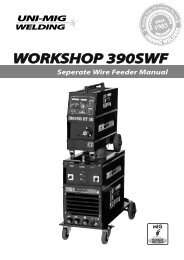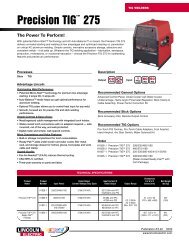Cleaning, Care & Maintenance of Stainless Steel - BJH
Cleaning, Care & Maintenance of Stainless Steel - BJH
Cleaning, Care & Maintenance of Stainless Steel - BJH
Create successful ePaper yourself
Turn your PDF publications into a flip-book with our unique Google optimized e-Paper software.
Atlas Specialty Metals<br />
<strong>Cleaning</strong>, <strong>Care</strong> & <strong>Maintenance</strong> <strong>of</strong><br />
<strong>Stainless</strong> <strong>Steel</strong><br />
Tech Note no. 5<br />
Pickling Treatments<br />
• All stainless steels (except free machining grades):<br />
8-11% sulphuric acid, at 65 to 80 o C for 5-45 minutes.<br />
• Grades with at least 16% chromium (except free machining grades):<br />
15-25% nitric acid + 1-8% hydr<strong>of</strong>luoric acid, at 20 to 60 o C for 5-30 minutes.<br />
• Free machining grades and grades with less than 16% chromium such as 303, 410<br />
and 416:<br />
10-15% nitric acid + 0.5-1.5% hydr<strong>of</strong>luoric acid, at 20 to 60 o C for 5-30 minutes.<br />
“Pickling Paste” is a commercial product <strong>of</strong> hydr<strong>of</strong>luoric and nitric acids in a thickener -<br />
this is useful for pickling welds and spot contamination, even on vertical and<br />
overhanging surfaces.<br />
Recommendations for <strong>Cleaning</strong> <strong>of</strong> Specific Products<br />
<strong>Stainless</strong> steel is easy to clean compared to many other materials. Washing with soap<br />
or a mild detergent and warm water followed by a clean water rinse is usually quite<br />
adequate for domestic and architectural equipment. An enhanced appearance will be<br />
achieved if the cleaned surface is finally wiped dry. Specific methods <strong>of</strong> cleaning are as<br />
in the table on the next page. These are recommendations only, and it must be<br />
recognised that there are risks associated with all cleaning operations. All such<br />
treatments must be evaluated by the user.<br />
PROBLEM CLEANING AGENT COMMENTS<br />
Soap or mild detergent and<br />
water. (preferably warm)<br />
Routine cleaning<br />
All finishes<br />
Fingerprints<br />
All finishes<br />
Stubborn stains and<br />
discolouration.<br />
All finishes.<br />
Lime deposits from<br />
hard water.<br />
Oil or grease marks.<br />
All finishes.<br />
Soap and warm water or<br />
organic solvent (eg acetone,<br />
alcohol, methylated spirits)<br />
Mild cleaning solutions. Ensure<br />
any proprietary cleaners state<br />
compatibility with stainless<br />
steel. Phosphoric acid cleaners<br />
may also be effective.<br />
Solution <strong>of</strong> one part vinegar to<br />
three parts water.<br />
Organic solvents (eg. acetone,<br />
alcohol, methylated spirits,<br />
proprietary “safety solvents”).<br />
Baked-on grease can be<br />
s<strong>of</strong>tened beforehand with<br />
ammonia.<br />
Sponge, rinse with clean<br />
water, wipe dry if<br />
necessary. Follow polish<br />
lines.<br />
Rinse with clean water and<br />
wipe dry. Follow polish<br />
lines.<br />
Use rag, sponge or fibre<br />
brush (s<strong>of</strong>t nylon or natural<br />
bristle. An old toothbrush<br />
can be useful). Rinse well<br />
with clean water and wipe<br />
dry. Follow polish lines.<br />
Soak in solution then brush<br />
to loosen. Rinse well with<br />
clean water.<br />
Clean after with soap and<br />
water, rinse with clean<br />
water and dry. Follow polish<br />
lines.<br />
Revised May 2006 3 <strong>of</strong> 5


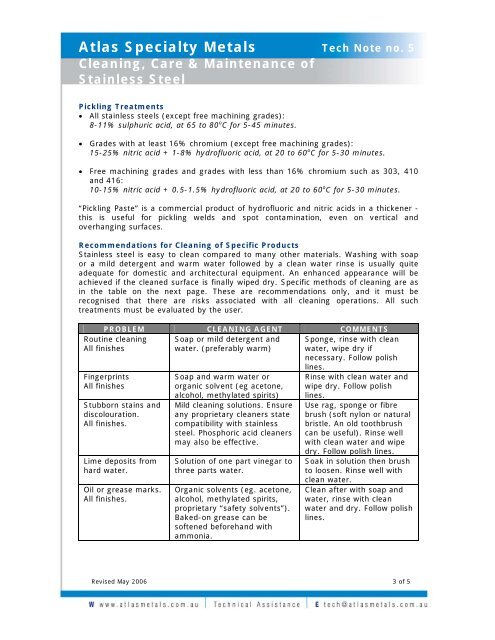


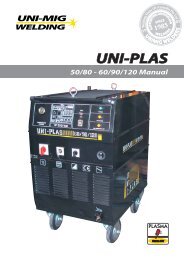
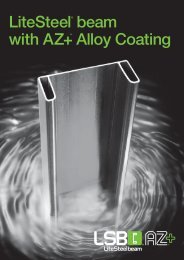

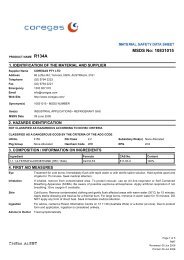

![Weldmatic 175 [internal wirefeeder] - BJH](https://img.yumpu.com/48683580/1/184x260/weldmatic-175-internal-wirefeeder-bjh.jpg?quality=85)




